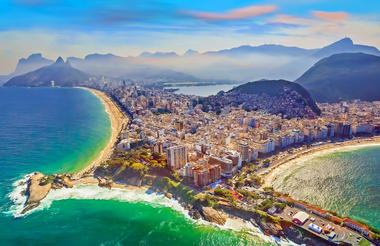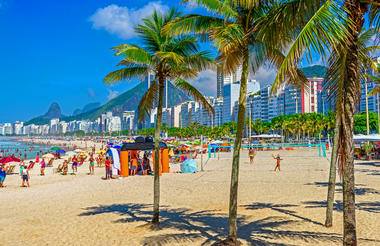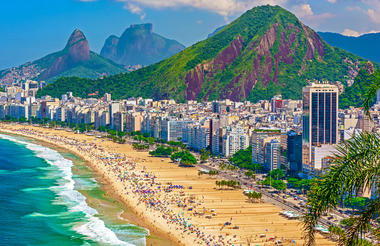Brazil is a vast, vibrant and magnetic country situated in the central-eastern part of South America, and lapped by the Atlantic Ocean. This melting pot of cultures, ethnicities, and religions is a product of its patchwork past of local traditions, colonial rule, and the influx of immigrants. It is South America’s largest country, with a landmass comparable to that of the United States, and a mosaic of ecosystems that supports the largest array of flora and fauna on the planet. The Brazilian people are typically warm and friendly, while the country’s natural diversity lends itself to myriad travel experiences, from idyllic coastal holidays and riotous Carnaval celebrations to stopovers in the dynamic cities of Sao Paulo and Rio de Janeiro. Adventures await outdoor enthusiasts in the enthralling Amazon jungle.
A dynamic coastal neighbourhood synonymous with leisure, luxury and nightlife, Copacabana is characterised by million-dollar penthouses, stunning neoclassical buildings and tiny apartments set against a magnificent backdrop of jungle-clad mountains in Rio de Janeiro. From its humble origins as a small fishing village, the "Princess of the Sea" is now a leisure seeker's paradise, bursting with restaurants, nightclubs, bars and hotels, and emits a lively, effervescent energy, perfect for the social traveller. To learn its history, visit Forte de Copacabana, a fort and museum that traces the early days of the Portuguese colony through to the mid-19th century. Art enthusiasts will appreciate a visit to The Eva Klabin Foundation (Casa Museu Eva Klabin), a historical home of famous art and antique collector Eva Klabin that houses over 1000 art pieces from all over the world. A visit to Copacabana is incomplete without the world-famous Copacabana Beach, a 4-kilometre stretch of golden sand dotted with brightly-coloured umbrellas, bars and a popular playground for watersports, football, volleyball, or simply lazing in the sun.



This magnificent waterfall marks the confluence of the Iguazu River in Argentina and the Parana River in Brazil, and the meeting of the two countries is marked by stone pillars rising from the water. It is said that the former first lady of America, Eleanor Roosevelt, exclaimed her ‘pity’ for her country’s Niagara Falls when she first encountered the beauty of Iguazu Falls. Roughly half the combined volume of both rivers thunders into the Devil’s Throat, a U-shaped cataract that delivers a torrential deluge of water into the wide basin below. Visitors can look forward to ample opportunities for excellent jet boat safaris, kayaking, hiking, biking, and more. Make sure to visit the extraordinary Iguassu Bird Park to see toucans and other brightly coloured exotic birds in their natural habitat.



Situated in northwestern Brazil where the mighty Solimoes, Negro, and Madeira rivers converge to form the grand Rio Amazonas, the Amazonas State is the largest in Brazil and is covered almost entirely by the Amazon rainforest. The rivers join at the capital port city of Manaus, which serves as a great base for exploring the area and offers some interesting forest tours and landmarks of its own. Visitors can look forward to taking a boat tour of the Rio Negro's Anavilhanas Archipelago and its hundreds of islands, occupied by a number of indigenous villages. Other popular attractions include the Jardim Botânico Adolpho Ducke in Manaus, the world’s largest urban forest, and, also in Manaus, the gorgeous opera house of Teatro Amazonas, built at the height of the rubber boom.



Manaus, located in northwestern Brazil on the banks of the Negro River in northwestern Brazil, is the capital of the Amazon, its largest city and primary tourism hub. Manaus is a bustling urban centre permeated with brightly coloured residential homes, modern high-rise buildings and tour offices where you can book jungle lodges and river cruises. The town lies near the confluence of the Negro and Amazon, known as the ‘Meeting of the Waters’, which is accessible by boat from Manaus. According to local lore, the two rivers run side by side for six kilometres without mixing and, in fact, it’s possible to feel the different temperatures of the two water sources by dipping your hand into the currents on either side of the vessel.



A visit to Trancoso on Brazil’s vast northeastern coast is an invitation to partake in ‘active loafing’. Made popular – perhaps rather aptly – by São Paulo's hippy set in the ‘70s, this former fishing village has its own languorous pace that sees most shops opening for business during the mid-afternoon. The powdery white sand and natural sea pools of Espelho Beach will occupy you in the meantime. Alternatively, visit the village’s landmark 16-century church – one of the oldest in Brazil and the focal point of the grassy Quadrada – or the town square, which is framed by colourful houses, eateries, and quaint accommodation. Kayaking, snorkelling, wind and kite-surfing can be arranged and for a taste of local action, visit the Capoeira Academy at the Uxua Casa Hotel.








